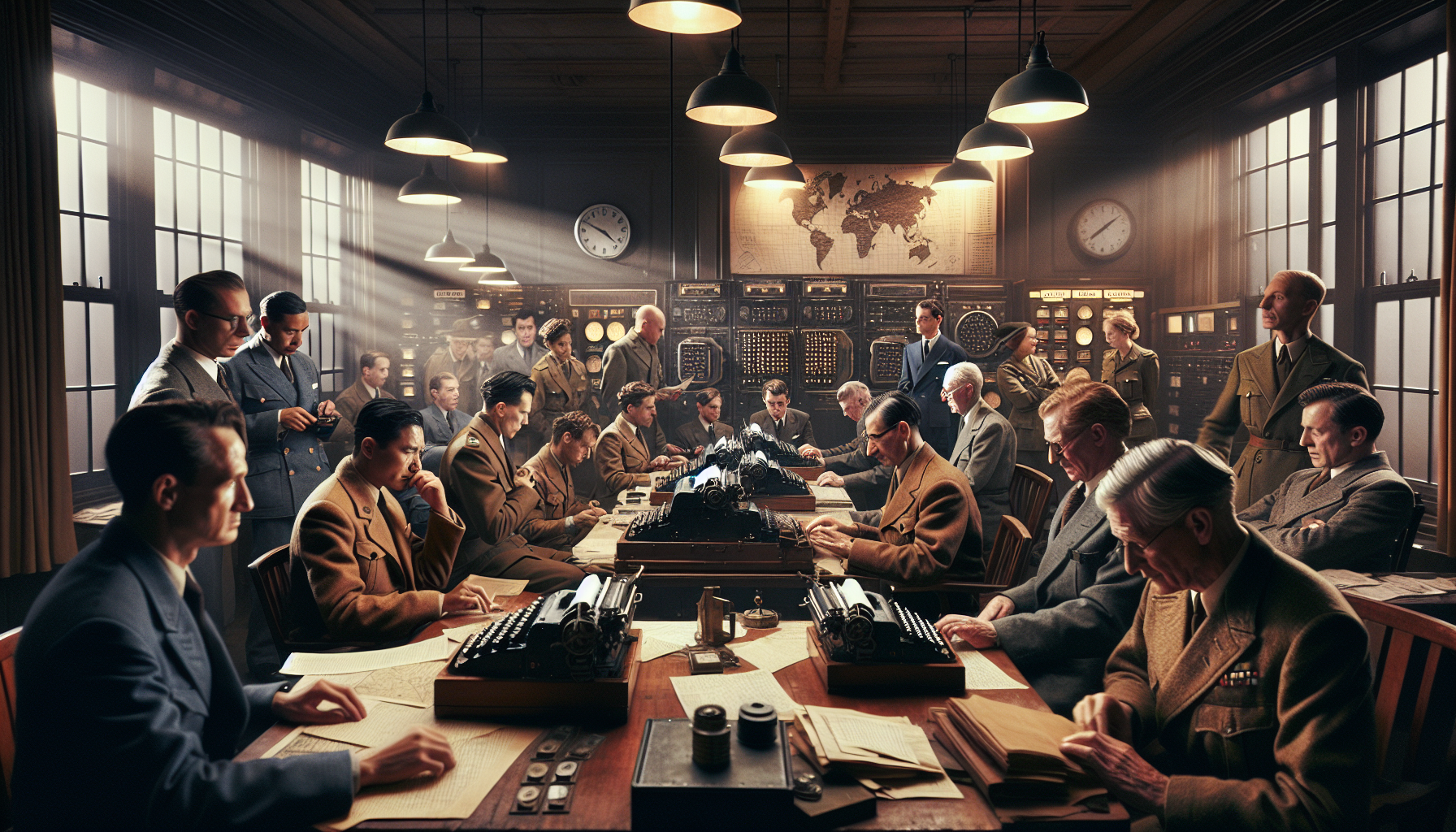In the intricate tapestry of human history, there are threads woven not with the clamor of swords or the thunder of cannons, but with the quiet, methodical artistry of the mind. These are the threads spun by the legendary codebreakers—men and women who, often shrouded in secrecy and obscurity, altered the course of wars and unmasked hidden secrets with nothing but intellect and perseverance. As the digital age engulfs us in its vast ocean of information, it is easy to forget that the very ability to secure and decipher secrets has been a pivotal force in shaping our world. It is a tale of brilliance and tenacity, where the sharpness of the human intellect has often been the ultimate weapon.
The history of codebreaking is a rich narrative filled with intrigue, deception, and extraordinary mental feats. These unsung heroes, operating in the shadows, have been pivotal in determining the outcomes of conflicts and unearthing secrets long buried in the sands of time. From the ancient scripts of Mesopotamia to the complex encryptions of World War II, the art of codebreaking has evolved, yet its essence remains unchanged: a battle of wits that demands unparalleled ingenuity and patience. But who were these individuals, and how did they manage to untangle the webs of deception spun by their adversaries? In exploring their stories, we uncover not just a historical account, but a testament to the unyielding spirit of human curiosity and ingenuity.
In this article, we embark on a journey through time, revisiting the fascinating stories of some of the most legendary codebreakers. Our journey begins with the early origins of cryptography, where we explore how ancient civilizations laid the groundwork for what would become a crucial element of warfare and diplomacy. We then delve into the high-stakes world of World War I and World War II, examining how codebreakers like Alan Turing and the cryptanalysts of Bletchley Park unraveled the secrets of the Enigma machine, altering the tide of battle and, indeed, the course of history. Along the way, we will also shine a light on lesser-known yet equally compelling figures, whose contributions have left an indelible mark on the field of cryptanalysis.
Yet, this is not merely a recounting of past triumphs. As we trace the evolution of codebreaking, we also reflect on its profound implications in our modern world. In an era where information is both a tool and a weapon, the lessons learned from these historical feats remain ever relevant. We will examine how contemporary encryption methods draw upon the principles established by these early pioneers and explore the ethical dimensions of privacy and security in today’s digital landscape. Through their stories, we find a mirror reflecting both the challenges and the opportunities that lie ahead.
Join us as we unlock the past, revealing the minds behind the codes that have, time and again, changed the course of history. This journey is not just an exploration of secrets and symbols; it is a celebration of the human spirit—a testament to our relentless pursuit of knowledge and our enduring quest to illuminate the unknown. As we delve into the lives and legacies of these remarkable individuals, we invite you to ponder the power of the mind and the enduring impact of those who dare to decode the mysteries of the world. 🌍🔍
The Enigma of Cryptography: From Ancient Ciphers to Modern Codes
The world of cryptography is as old as civilization itself, with roots tracing back to ancient Egypt and beyond. Throughout history, the art of concealing information has played a pivotal role in the shaping of empires, the waging of wars, and the safeguarding of secrets. Cryptography, in its essence, is the practice of writing or solving codes. It involves creating codes (encryption) to protect information and deciphering them (decryption) to retrieve hidden messages. As technology advanced, so did the sophistication of these codes, leading to an arms race of sorts between codemakers and codebreakers. 🗝️
In ancient times, cryptography was used primarily for military purposes, with generals and leaders keen to keep their communications secret from enemies. Simple substitution ciphers, where each letter in the plaintext is shifted a certain number of places down or up the alphabet, were commonly used. One of the earliest known examples of a substitution cipher is the Caesar Cipher, reportedly used by Julius Caesar to communicate with his generals. As time passed, these basic methods gave way to more complex systems. Fast forward to the Middle Ages, and we find the invention of the Vigenère cipher, a method that uses a keyword to shift letters, offering a greater degree of complexity and resistance to brute force attacks.
The evolution of cryptography took a quantum leap in the 20th century with the advent of the Enigma machine, a device used by Nazi Germany during World War II to encrypt military communications. The Enigma machine’s intricate system of rotors and wiring meant that it could generate a vast number of possible combinations, making it an incredibly formidable tool for maintaining the secrecy of messages. However, the Enigma was not infallible. It was the work of brilliant codebreakers that led to the cracking of the Enigma code, a turning point in the war effort against the Axis powers. This breakthrough not only shortened the war by several years but also saved countless lives.
The Unsung Heroes: Codebreakers of World War II
Among the most legendary codebreakers of World War II was Alan Turing, a mathematician and logician whose work laid the foundations for modern computing. Turing’s contributions to breaking the Enigma code are well-documented, and his story has been immortalized in books and films alike. At Bletchley Park, the epicenter of British codebreaking efforts, Turing and his team worked tirelessly to develop machines that could simulate the workings of the Enigma, eventually leading to the construction of the Bombe, a device capable of deciphering Enigma messages.
But Turing was not alone. The team at Bletchley Park included many other brilliant minds, each bringing unique skills to the table. Women played a crucial role in these efforts, with figures like Joan Clarke, who was not only an accomplished cryptanalyst but also one of the few women to hold a senior position at Bletchley Park. Their work, conducted in utmost secrecy, contributed significantly to the Allied victory and highlighted the power of collaboration in overcoming seemingly insurmountable challenges.
The impact of their work extends far beyond the war itself. The techniques developed at Bletchley Park laid the groundwork for future innovations in computing and artificial intelligence. Turing’s vision for a machine capable of performing any conceivable mathematical computation, now known as the Turing Machine, was revolutionary. Today, his legacy lives on in the form of modern computers and digital encryption methods that secure our communications and protect our data.
Modern Cryptography and Its Role in Today’s Digital World
As we moved into the digital age, cryptography evolved to meet new challenges and address the growing need for secure communication across the internet. The development of public key cryptography in the 1970s marked a significant milestone, providing a secure way to exchange information without the need for a shared secret key. This method involves the use of a pair of keys: a public key, which is shared openly, and a private key, which is kept secret by the owner. Together, they enable secure communication and digital signatures, forming the backbone of online security protocols today.
Another major development in modern cryptography is the rise of quantum cryptography, which leverages the principles of quantum mechanics to create theoretically unbreakable codes. This emerging field promises to revolutionize the way we secure information, making it immune to the computational power of future quantum computers. However, the implementation of quantum cryptography on a large scale remains a complex challenge, requiring significant advances in technology and infrastructure.
In the realm of consumer technology, encryption plays a critical role in protecting personal data and ensuring privacy. From messaging apps like WhatsApp and Signal, which use end-to-end encryption to safeguard conversations, to secure online transactions and storage, cryptography is an integral part of our daily lives. Yet, as technology continues to advance, so do the methods used by cybercriminals to breach these defenses, leading to an ongoing cat-and-mouse game between security experts and hackers.
Case Study: The Enigma Machine vs. The Codebreakers
To truly appreciate the impact of codebreakers on the course of history, one must examine the battle between the Enigma machine and the Allied codebreakers during World War II. This case study not only highlights the ingenuity and determination of the codebreakers but also underscores the strategic importance of cryptography in warfare.
The Enigma machine, developed in the 1920s and adopted by the German military in the 1930s, was considered one of the most secure encryption devices of its time. Its complexity stemmed from its use of a series of rotating rotors and plugboards, which created a vast number of possible configurations. Each message sent by the Enigma had a unique encryption key, which changed daily, further complicating the codebreaking efforts.
Despite these challenges, the codebreakers at Bletchley Park made significant strides in deciphering Enigma messages, thanks to a combination of mathematical prowess, ingenuity, and a bit of luck. One of the key breakthroughs came from the work of Polish cryptanalysts, who shared their findings with the British and French intelligence services prior to the outbreak of war. This collaboration set the stage for the later successes at Bletchley Park.
To delve deeper into the fascinating history of the Enigma machine and the efforts to break its code, I recommend watching the following video: “The Enigma Machine Explained” by The History Guy: History Deserves to Be Remembered. This video provides a detailed overview of how the machine worked and the incredible efforts that went into cracking its code.
Comparative Analysis: Cryptographic Methods Through the Ages
To fully grasp the evolution of cryptography, it’s essential to compare the various methods used throughout history, highlighting their strengths and weaknesses. The table below offers a comparative analysis of some of the most notable cryptographic techniques, from ancient times to the modern era. 📜
| Cryptographic Method | Era | Strengths | Weaknesses |
|---|---|---|---|
| Caesar Cipher | Ancient Rome | Simple to use and understand | Easily broken with frequency analysis |
| Vigenère Cipher | Renaissance | More secure than simple substitution | Vulnerable to Kasiski examination |
| Enigma Machine | World War II | Highly complex with many permutations | Deciphered through collaborative effort and innovation |
| Public Key Cryptography | Modern Era | Secure exchange without shared secret | Relies on computational assumptions |
| Quantum Cryptography | Future | Theoretically unbreakable | Requires advanced technology and infrastructure |
As we continue to explore the world of cryptography, it’s clear that the field is in a constant state of evolution. New challenges and technologies arise, prompting innovative solutions and adaptations. Understanding the historical context of these methods helps us appreciate the progress made and the impact of cryptography on our lives today.
If you’re interested in seeing how some of these cryptographic methods have been visualized, check out the engaging video: “How to Make a Caesar Cipher Wheel” by Make It Easy Education. This practical demonstration offers a hands-on approach to understanding one of the most famous ciphers.
- Explore the historical impact of cryptography on wars and diplomacy.
- Learn about the key figures in the development of modern cryptography.
- Stay informed about the latest advances in quantum cryptography.

Conclusion
In conclusion, the exploration of the legendary codebreakers who changed the course of wars and unveiled secrets has provided us with a profound appreciation of their monumental contributions to history. Throughout this article, we delved into the complex world of cryptography and the pivotal figures who harnessed their genius to decipher seemingly impenetrable codes. These codebreakers, operating in the shadows, wielded their intellectual prowess to tip the scales in significant historical conflicts, thereby altering the trajectory of world events.
One of the primary themes we examined was the role of cryptography in warfare. We highlighted how codebreaking became a crucial tool for military strategy, enabling nations to intercept and interpret enemy communications. This strategic advantage often determined the outcomes of battles and, ultimately, wars. From the efforts of the Allied forces in World War II to decipher the Enigma machine, to the intricate work of codebreakers during the Cold War, their contributions cannot be overstated.
Furthermore, we celebrated the individual stories of remarkable codebreakers such as Alan Turing and the Bletchley Park team, who were instrumental in cracking the Enigma code. Their work not only shortened the war by years but also laid the groundwork for modern computing, showcasing how their legacy extends far beyond the battlefield. We also touched upon the incredible achievements of lesser-known figures, such as Elizebeth Smith Friedman, whose pioneering work in codebreaking helped bring down notorious criminal organizations and thwart espionage activities.
The article also shed light on the evolution of cryptography, tracing its origins from simple ciphers to the complex algorithms that protect our digital communications today. This evolution underscores the perpetual arms race between code makers and codebreakers, a dynamic that continues to shape our world in the digital age. The history of codebreaking is not just a tale of past achievements; it is a living narrative that informs current cybersecurity practices and national security strategies.
In emphasizing the importance of this topic, we recognize that understanding the history of codebreaking is crucial not only for its historical value but also for its implications in today’s world. As we navigate an era defined by rapid technological advancements and growing cyber threats, the lessons from these legendary codebreakers serve as a reminder of the power of human ingenuity and the relentless pursuit of knowledge. Their stories inspire us to think critically, approach problems with creativity, and remain vigilant in the face of challenges.
We encourage readers to reflect on the remarkable achievements of these codebreakers and consider the broader implications of their work. Whether you are a history enthusiast, a technology buff, or simply curious about the forces that have shaped our world, there is much to learn and appreciate from the legacy of codebreaking. Moreover, sharing this knowledge and engaging in discussions about its impact can foster a deeper understanding of the delicate balance between security and privacy in our interconnected world.
To further explore this fascinating topic, we recommend visiting reputable resources such as the National Cryptologic Museum https://www.nsa.gov/visit/national-cryptologic-museum/, which offers insights into the history of cryptography and the contributions of codebreakers. Additionally, online archives and documentaries, such as those available on the Bletchley Park Trust website https://bletchleypark.org.uk/, provide a wealth of information for those eager to delve deeper into the stories of these unsung heroes.
In closing, the saga of the legendary codebreakers is not merely a chapter in history but a testament to the enduring spirit of innovation and resilience. Let their stories inspire you to explore the mysteries of the past, challenge the limits of what is possible, and contribute to a future where knowledge is the key to unlocking new frontiers. Share this article with friends, spark conversations, and apply the lessons learned from these extraordinary individuals to your own pursuits. Together, let’s honor their legacy and continue to unlock the secrets of our world. 🌟
Toni Santos is a visual cryptographer and artisan, weaving hidden meaning into every line, curve, and composition. His creations delve into the mysterious world of secret codes, symbolic alphabets, and invented languages, transforming visual art into a rich tapestry of communication beyond words.
Guided by a lifelong fascination with hidden knowledge and the power of symbols, Toni explores how meaning can be embedded, concealed, and rediscovered. From constructed glyphs to encoded illustrations, each piece he creates serves as a portal to a deeper layer of understanding — one that invites curiosity, interpretation, and wonder. His work bridges the intuitive with the intellectual, the mystical with the methodical.
With roots in handcrafted artistry and a background in visual semiotics, Toni fuses form and function to create works that whisper rather than shout. These are not just images — they are visual riddles, poetic encryptions, and artifacts of a language yet to be spoken.
As the creative mind behind Vizovex, Toni offers a space where art meets encryption, and viewers are invited to decode, reflect, and engage. Through symbolic design, visual lexicons, and explorations into constructed languages, he builds a universe where meaning is layered, intentional, and always slightly out of reach — waiting to be discovered.
His work is a tribute to:
The unseen languages that shape our perception
The art of hidden messages and symbolic systems
The thrill of decoding and the beauty of mystery
Whether you’re a language lover, a codebreaker at heart, or someone drawn to the enigmatic, Toni invites you to explore a world where expression transcends convention — one glyph, one message, one mystery at a time.





